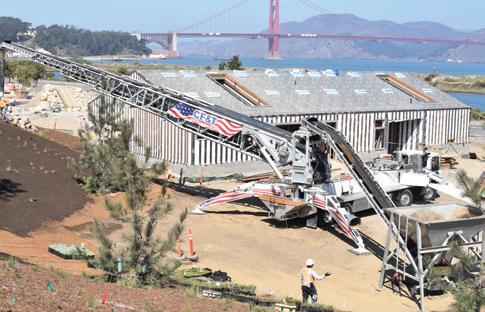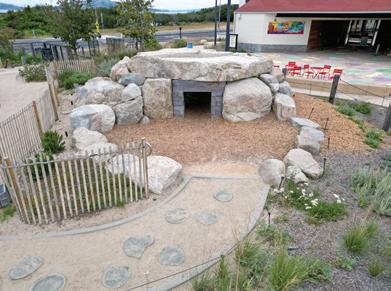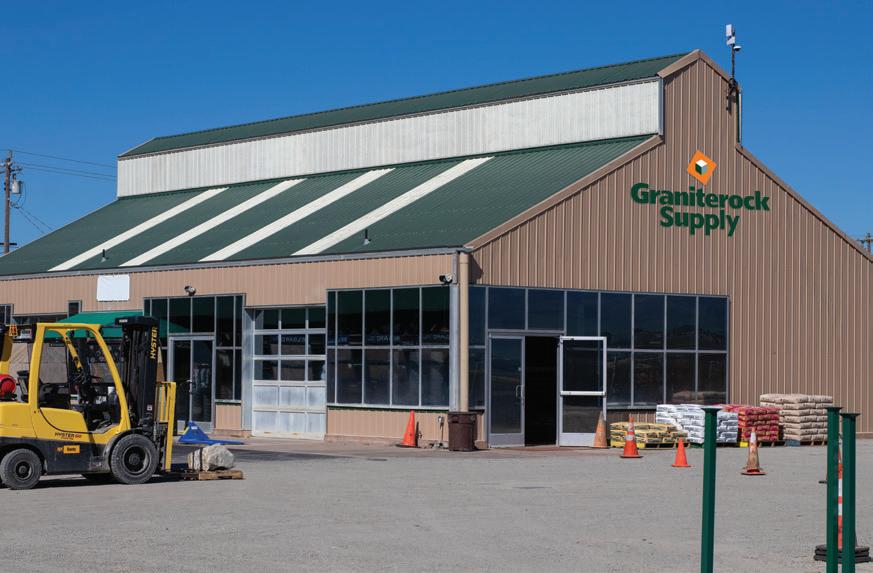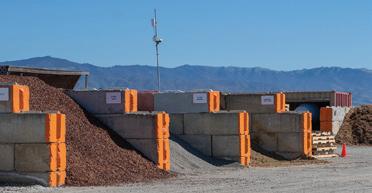Presidio Tunnel Tops: McGuire and Hester Delivers
Exceptional Landscaping Work as Subcontractor to Swinerton Construction







If you’re ready to put a reliable
to
we are too. Give us a call.

Presidio Tunnel Tops: McGuire and Hester Delivers
Exceptional Landscaping Work as Subcontractor to Swinerton Construction







If you’re ready to put a reliable
to
we are too. Give us a call.

John Deere's compact construction equipment is engineered to meet the diverse needs of landscaping professionals. Whether you're sculpting terrain, transporting materials, or installing hardscapes, our machines offer the power, precision, and versatility required to elevate your projects.





















By Brian Hoover, Editor / Photos by McGuire and Hester

Perched above San Francisco’s iconic waterfront, the Presidio Tunnel Tops project exemplifies an extraordinary blend of landscape architecture, sophisticated engineering, and environmental stewardship. This ambitious undertaking transformed a highway corridor into 14 acres of vibrant, accessible parkland. The project links the historic Presidio Parade Grounds with Crissy Field and the Golden Gate shoreline, creating a seamless recreational and community space.
General contractor Swinerton Builders spearheaded the overhead work on the Tunnel Tops project, and was responsible for delivering site infrastructure, utilities, learning buildings, playground installations, site furnishings, and extensive landscape features. Prior to Swinerton’s involvement, Caltrans performed the highway realignment and tunnel construction under a separate contract. Notably, Swinerton also managed the construction of repurposed Presidio cypress benches and tables, as well as coordinating the intricate
logistics involved in replacing the elevated Doyle Drive viaduct with low-profile tunnels. Their expertise in complex infrastructural projects was instrumental in successfully integrating landscape and architectural components to create this unified public space.
As the landscape subcontractor working under Swinerton, the McGuire and Hester Landscape Division played a crucial role in this landmark achievement.
Originating from a joint venture with a local well-known firm around 2005, the division has evolved into a leading landscaping provider in Northern California.
Division Manager, Matt Daley, joined the company in 2008, bringing significant experience from major landscaping projects across the Bay Area. Project Manager, Shannon Halabrin joined full-time in 2018 after her internship, where she worked on San Francisco’s acclaimed Salesforce Park,
contributing advanced technological insights and a fresh perspective gained from her education at Cal Poly San Luis Obispo.
McGuire and Hester offers comprehensive services, including underground utilities, mass excavation, grading, paving, concrete work, irrigation, and landscape installation. Operating primarily in the Bay Area and Sacramento, its flexible model allows the division to serve as both prime contractor and subcontractor, a versatility made possible by their civil general engineering construction background dating back to 1926 when Mike McGuire and Mike Hester began installing sewers in the Oakland area.
Landscape work began on Presidio Tunnel Tops in March 2020, with McGuire and Hester responsible for substantial infrastructural upgrades, including installing underground utilities to include water, sewer, stormwater

management systems, and some limited gas infrastructure.
One of the project’s signature elements involved the installation of over 1,000 tons of custom-carved boulders for various features, including an amphitheater and interactive play structures. These boulders required precise mockups, advanced waterjet cutting techniques, and extensive logistics management, transporting materials from Hollister to Petaluma before final installation. Additionally, approximately 25,000 cubic yards of soil were imported to create a planting bed atop the tunnels covering Doyle Drive, now known as Presidio Parkway.
The planting scope was impressive, encompassing approximately 70,000 bulbs, 164,000 plants, and 145 trees, ranging from modest 24-inch boxes to substantial 84-inch specimens. Employing advanced GPS-guided planting methods with AutoCAD and Topcon systems, the team ensured meticulous plant placement and aesthetic harmony. Rigorous Phytophthora control protocols, including stringent pear bait testing, were integral to safeguarding plant health.
“The planting was more complex than your typical installation project.

We used GPS handheld systems to spray paint boundaries for each plant, creating what must have looked like a large painting from the air,” says Shannon Halabrin, Project Manager, McGuire and Hester.
“The Presidio Nursery grew about 70% of the plant material, all sourced from seed, to prevent introducing Phytophthora. Everything else had to undergo rigorous testing. Plant replacement was less than one percent, coming in as one of the best results we’ve seen on any major project. This was truly a testament to our team members preparation and care.”
Environmental responsibility was paramount. To prevent root intrusion, the landscape design strategically excluded large trees over the tunnels, focusing on resilient ground covers and smaller plants. Innovative erosion control methods using coconut fiber mats replaced conventional plastic geo-grids, underscoring McGuire and Hester’s commitment to sustainability.
Significant rainfall in 2021 posed a substantial challenge, causing soil erosion and necessitating considerable restoration efforts. Meticulous soil moisture monitoring and adaptive construction schedules ensured project quality despite adverse weather conditions.
The project included several special application methods and had its fair share of challenges. “We custom fabricated boulder features, mocking them up multiple times before having them precisely cut to specification prior to installation. Our crews also utilized our sister company CF&T Concrete Pumping, who operated a telescoping conveyor that was critical for precise soil placement. This also allowed our crews to safely navigate the load restrictions over the tunnels,” continues Halabrin. “As far as challenges, heavy rains were responsible for a washout during the initial placement of dirt and rocks, revealing the tunnel structure in the process. It was a big setback,but we worked through it methodically and carefully restored everything back to design specifications.”
Archaeological considerations also played a significant role. Onsite monitoring uncovered historical artifacts, including an 1800s sword sheath and ship mast fragments. These discoveries added cultural depth to the project without hindering progress, highlighting the site’s historical significance.
The project’s technical demands required a diverse fleet of equipment, including CAT 308 and 303 mini excavators, in addition to skid steers, wheel loaders, forklifts, and a

Above and Top Right: McGuire and Hester’s sister company CF&T Concrete Pumping utilized a telescoping conveyor, which was critical for precise soil placement.



telescoping conveyor belt truck for precision soil placement. For deeper excavations, up to 30 feet in sandy, high-water-table conditions, the larger CAT 349 excavators were employed alongside extensive shoring and dewatering methods.
Notably, the project featured strong female leadership at multiple levels, from project management to landscape architecture, fostering a collaborative and inclusive workplace culture. This aspect significantly contributed to the project’s successful outcomes, as McGuire Hester continues to set a standard within the landscaping and construction industries. The seamless teamwork among all contributors helped bring this complex civic vision to life with high quality and environmental sensitivity.
The completed Presidio Tunnel Tops has achieved extraordinary success, with plant survival rates exceeding 99%, attesting to McGuire and Hester’s meticulous planning, execution, and maintenance practices. Stakeholders, including the Presidio Nursery, have expressed substantial satisfaction, reinforcing the division’s reputation for excellence.
“This project was a collaborative effort and required tremendous coordination between the general public, local residents, Swinerton, the design team and all of the other trades, as well as a long list of stakeholders including Presidio Trust, the National Park Service, Golden Gate National Parks Conservancy, San Francisco Board of Supervisors, San Francisco County Transportation Authority

Caltrans and the State of California, among many other entities,” says Matt Daley, McGuire and Hester Landscape Division Manager. “We worked closely with the lead design firm, James Corner Field Operations, and the EHDD Architecture, who was responsible for the design of structures within the park, such as the Field Station, Visitor Center and Transit Center. Everyone knew what had to be done and we all worked together wonderfully. Of course, I want to specifically thank and recognize our crews, who did such a magnificent job on this high-profile project.”
{ Continued on page 10 }

















The Presidio Tunnel Tops supports diverse community uses, offering scenic overlooks, winding pathways, fire-circle gathering areas, picnic terraces, and youthfocused play spaces such as The Outpost. Accessibility features, including ramps and inviting plazas, ensure all visitors can enjoy panoramic views of the Golden Gate Bridge, Bay, and historic Main Post.
Within the first year, Tunnel Tops registered nearly 1.8 million visits, hosted over 100 community events, and attracted 400,000 visitors to its play areas. This underscores its significant social and ecological contributions, transforming urban infrastructure into vibrant community amenities.
In July 2024, the Presidio Tunnel Tops expanded, transforming
adjacent parking areas into additional green spaces with picnic areas and bike parking facilities. A second phase, Outpost Meadow, announced for late 2025, will add another 1.5 acres, further enhancing the park’s community and environmental benefits.
The Presidio Tunnel Tops project has already received recognition and awards. Recently the ASLA Northern California Chapter announced the winners of its 2025 Professional and Student Design Awards, recognizing outstanding achievements in landscape architecture across nine categories. This year’s honors included one Award of Excellence, nine Honor Awards, 15 Merit Awards, and for the first time, included Biodiversity and Climate Action Awards. The Presidio Tunnel Tops project was presented the prestigious Award of Excellence in general design.
Setting a new benchmark, The Presidio Tunnel Tops stands as a landmark achievement, combining

visionary design with ecological sensitivity and community engagement. McGuire and Hester’s contribution to this project has not only transformed an urban corridor into a beloved public space but has also set new standards for landscape architecture, sustainability practices, and infrastructure renewal. This iconic landscape symbolizes a powerful example of how innovative planning and skilled execution can redefine urban landscapes, inspire community connections, and preserve natural beauty within an urban environment.
For more information on McGuire and Hester, please visit www.mcguireandhester.com or call their Oakland headquarters at (510) 632-7676. CL




Graniterock, one of California’s oldest and most respected construction materials companies, recently rebranded its Building Materials division as Graniterock Supply. The name change reflects broader offerings, and a focused growth strategy designed to enhance service to landscaping and hardscaping contractors, civil general engineering firms and homeowners throughout the Central Coast and San Francisco Bay areas.
Jeff Lindsay, building materials business manager at Graniterock Supply, said the new name positions the company as “the go-to source for all things construction supply.” He emphasized that the rebrand honors Graniterock’s heritage while aligning with its expanding capabilities. “We’re not just selling products, we’re building relationships,” Lindsay said.
Graniterock Supply operates six branches across California’s Central Coast, including locations in Watsonville, Seaside, Santa Cruz, Salinas and Redwood City. These locations provide comprehensive

inventories tailored to local market needs, spanning three primary product lines: construction, hardscape and landscape materials.
Chris Wilson, the southern building materials manager at Graniterock Supply, noted the importance of the new name. “We’re excited to introduce Graniterock Supply as the new face of our building materials business,” he said. “The name marks a renewed
commitment to being the trusted partner our customers rely on every day.”
Graniterock Supply marked the rebranding with a grand opening celebration at its new Highway 68 branch in Salinas in early April. The event attracted contractors, architects and local businesses, showcasing a wide array of construction and landscaping products. Graniterock Supply’s



diverse inventory includes decorative landscape materials such as flagstone, porcelain pavers and retaining wall blocks, as well as structural hardscape and masonry products. Additionally, Graniterock Supply offers sacked goods, sealers, stucco supplies and a variety of tools essential for construction projects. “We opened a new location in Salinas a couple of months ago, giving us two stores there. Our business is structured like a threelegged stool: construction building materials, landscape products and hardscape materials, such as stone veneer and pavers,” Chris said. “We’ve intentionally drawn clearer lines between these segments to enhance efficiency.”
Graniterock Supply distinguishes itself with its extensive logistics capabilities. “Our real strength is

our ability to deliver products to areas with challenging geography, from narrow mountain roads in Woodside down to tight streets in Carmel Valley,” Chris said. “We’re known for successfully navigating areas and supplying a long list of products to places that others will not deliver.”
Graniterock’s vertical integration, owning quarries, ready-mix concrete operations and hardscape materials, strongly positions it within the market, attracting contractors seeking comprehensive and reliable supply sources. Among Graniterock Supply’s notable clients is Stowe Contracting, Inc., a high-end home builder on the Central Coast who has been a loyal customer for many years. Stowe Contracting
Left and Inset:
The grand opening of Graniterock Supply on Highway 68 in South Salinas signals the company’s continued growth and commitment to serving the Monterey County construction community with construction materials.
Below Middle: Jeff Lindsay, Building Materials Business Manager.


offers complete construction services with grading, excavating, and paving stone divisions.
Established in 1987, Stowe Contracting serves central California, from Monterey and Carmel Valley northward to San Francisco. Walt Combs is the paving stone division supervisor for Stowe Contracting Inc. (Stowe), based in Marina, and he has worked for the company for 35 years. Stowe specializes in paving stone driveways, patios, and retaining walls, which constitute about a third of the business. Combs praises Stowe’s longstanding partnership with Graniterock Supply, highlighting exceptional service, dependable deliveries, and competitive pricing on quarry products, base rock, sands, pavers, retaining walls, and



related supplies. “Their service is unmatched, and that’s why we’ve stayed with them all these years,” Combs said. “Graniterock Supply has an incredible inventory of products, and they always make sure that our materials are delivered on time and to specifications. We work with Elizabeth Ray and Chris Wilson, who both do an exceptional job meeting and exceeding our needs.”
A significant part of Graniterock’s identity involves sustainability. The A.R. Wilson Quarry, located in Aromas near Watsonville, hosts a six-megawatt solar array powering roughly 65% of its annual electricity needs. The Watsonville-based headquarters has achieved near net-zero energy use. The company also prioritizes recycling stormwater, asphalt, concrete and reclaimed materials while using advanced emissions controls and CARBcompliant vehicles.
The Graniterock legacy started in 1900 when founder A.R. Wilson established the company. Over more than a century, Graniterock evolved from a local quarry operator to one
of California’s premier suppliers of aggregates, concrete, asphalt and recycled materials, while also handling heavy civil construction and transportation services under California contractor’s license No. 22.
Looking ahead, Graniterock Supply aims to continue growing its customer base in the region. “We’re actively looking at expanding further to better serve customers who currently find themselves just beyond our optimal service range,” Chris explained.
In addition to geographic growth, Graniterock Supply is exploring enhanced e-commerce opportunities. Chris noted the importance of digital platforms for future growth, referencing his previous management experience with Home Depot. “We recognize the value of online platforms for convenience and time savings, even though we primarily serve contractors rather than the broader retail market,” he said.
Graniterock’s core values, safety before all else, dedication to customers, building great lives, honesty, integrity and make it better, drive operations and strategic
initiatives. The company’s internal mantra underscores these values: “Graniterock thrives when our people thrive.”
The transformation to Graniterock Supply represents an intentional shift toward clearer branding, improved customer experiences and strategic market positioning. With product diversification and targeted geographic expansion, Graniterock Supply is poised to remain a cornerstone of California’s construction industry, serving as a reliable, comprehensive partner for building, landscaping and hardscape supply needs. “The updated identity helps the company be the go-to source for all things construction supply,” Jeff said. “Whether you’re a homeowner tackling a backyard renovation or a contractor managing a commercial site, our team is here to help you find the right materials and provide expert advice.”
For more information or to locate a nearby branch, visit graniterock. com or contact Graniterock Supply media relations in Watsonville at 831-768-2500. CL









The Greenbuild International Conference + Expo, the world’s leading annual event for professionals in sustainable building and green design, is set to take place Nov. 4–7, 2025, at the Los Angeles Convention Center. Hosted by Informa Connect in partnership with the U.S. Green Building Council (USGBC), Greenbuild 2025 will bring together global leaders in architecture, engineering, construction, development, public policy and environmental sustainability.
This year’s event will draw attendees from more than 59 countries, making it a global platform for groundbreaking ideas
10,000+ green building professionals from over 59 countries.

and solutions shaping the future of the built environment. Conference programming will explore key topics such as LEED v5, Passive House, and resilience strategies, along with innovations in health, wellness, equitable design, circular economies and zero-waste practices. New for 2025 is the Sustainable Finance & Investing Forum, which will examine topics like ESG performance, real estate investment trusts (REITs), and green financial models.
Conference sessions will take place across the South Hall, Concourse, Petree Hall and other meeting spaces within the Los Angeles Convention Center. While
the full conference spans four days, the expo will be open Nov. 5–6, showcasing hundreds of exhibitors offering demonstrations and insights into the latest in green building products and certifications, including LEED, WELL, TRUE, SITES, EDGE and PEER. Parking is available in the South Hall garage. This year’s keynote speaker, scheduled for Friday, Nov. 7 at 11:30 a.m., is Gloria Walton, president and CEO of The Solutions Project. Walton is a recognized leader in climate justice and has been named one of the “50 Most Powerful Women in Philanthropy.” Her address is expected to highlight the role of equity, climate
advocacy and community-led innovation in driving sustainable change.
Greenbuild 2025 will feature more than 100 sessions and over 300 speakers addressing emerging themes such as artificial intelligence in sustainable design, communityscale interventions, climate resilience and the evolution of healthy supply chains. Attendees will also benefit from structured networking opportunities, including curated meetups, one-on-one sessions and evening social events designed to foster peer-to-peer connection and cross-disciplinary collaboration.
Beyond the convention walls, Greenbuild will offer a range of educational tours across Los Angeles on Nov. 3 and Nov. 7, spotlighting notable local projects such as zero-energy buildings, green roofs and community
sustainability initiatives. The event’s high standards have earned it EIC Platinum, and TRUE Gold certifications, reinforcing its commitment to climate action, equity and circularity in practice.
Greenbuild 2025 promises a dynamic convergence of innovation, collaboration and thought leadership. For those invested in building healthier, more sustainable communities,it remains a can’t-miss event. For more information, visit the official Greenbuild website (www.GreenbuildExpo.com) for session guides, travel details and registration options. Registration is open. CL

250+ cutting-edge exhibitors showcasing the latest sustainable building technology.






As climate change intensifies and droughts continue to strain California’s water supply, a growing number of landscape professionals are turning to regenerative landscaping, an approach that moves beyond sustainability to actively restore soil health, improve biodiversity, and strengthen ecosystems.
Regenerative landscaping is rooted in the belief that landscapes should give more than they take. Instead of merely conserving resources or maintaining the status quo, this design philosophy aims to rebuild natural systems. For California’s landscape contractors, this means incorporating practices that not only reduce water use and chemical inputs but also regenerate the soil, support pollinators, and create climate-resilient green spaces.
Joshua Graning and Fred Hunter founded Regenerative Landscape Alliance, also known as ReGen
Coop, approximately 10 years ago in Santa Barbara. Originally sparked by an earthworks workshop in Carpinteria, the pair recognized the potential for capturing stormwater through innovative methods such as swales and ponds, techniques that not only conserve water but actively nourish surrounding landscapes. The cooperative transitioned from Fred Hunter’s original landscaping business, allowing multiple individuals to become part owners. Josh Graning reflected on this inclusive model, stating, “Fred was gracious enough to open up the opportunity so that multiple people could work in and be co-owners of the company.”
Joshua Graning is an enthusiast of all things regenerative. He holds a Permaculture Design Certification, Greywater Installer’s Certification, and is a Green Gardener. As a member-owner and foreman at ReGen Coop, Josh also serves
as a greywater specialist and earthworks expert. He studied Environmental Horticulture at Santa Barbara City College and continues to actively educate himself in rainwater harvesting and earthworks, driven by a passion for integrated ecological design.
ReGen Coop offers comprehensive landscaping services including consultation, design, installation, maintenance, and management. The team’s distinct specialty lies in regenerative landscapes, ecological designs aimed at actively restoring, and strengthening local ecosystems. According to Josh, their mission is clear: “Our main goal is ecological landscapes that are regenerative and ultimately resilient to the temperature changes and weather challenges we face in California.”
The cooperative specializes in rainwater harvesting earthworks, rain tank systems, greywater
systems, irrigation, and water management, emphasizing waterwise, native, and Mediterranean landscapes. Drawing from a robust foundation in permaculture, ReGen Coop integrates edible, climate-appropriate plants into their designs, significantly enhancing soil carbon, productivity, and aesthetic appeal. Josh highlighted the broader ecological benefits of these regenerative practices, especially soil health improvements. “By building soil health and covering the soil with mulch or plants, you’re actually lowering soil temperature and boosting its microbiome,” he explained. “For every 1% increase in soil organic matter on a one-acre parcel, you can enhance water storage capacity by up to 20,000 gallons.” This approach markedly reduces the reliance on external irrigation, underscoring its sustainability.
A key component of regenerative landscaping is soil health. Conventional landscapes often rely on synthetic fertilizers and compacted soils, which degrade microbial life and increase runoff. In contrast, regenerative projects focus on composting, mulching, and planting cover crops to build rich, biologically active soils. Josh defined regenerative landscaping succinctly: “The basic notion is to work with nature rather than against it, building landscapes more aligned with what the ecology and our natural environment prefer. We minimize inputs like herbicides, pesticides, fungicides, and fertilizers, opting instead for simple things such as compost, mulch, and plants to build up nature and habitat.” These landscapes predominantly feature plants adapted to California’s Mediterranean-like climate, thriving naturally with reduced water usage.
Techniques such as sheet mulching, biochar application, and vermicomposting are becoming common tools in the regenerative toolkit. Contractors also report



Top Left: Joshua Graning, Regenerative Landscape Alliance.
Top Right: Regenerative landscapes prioritize native, plants, habitat corridors and pollinator-friendly designs while also reducing maintenance and water usage.
Above: Regenerative landscaping is not a one-size-fits-all solution, but a dynamic process that requires education, collaboration, and observation.
using native mycorrhizal inoculants to boost root development and enhance plant resilience. ReGen Coop also promotes localized food production through “food forests,” landscapes integrated with edible plants and fruit-bearing trees, providing fresh produce and supporting local wildlife. Josh emphasized this aspect, stating, “The average piece of food travels about 1,500 miles from its origin to the shelf. Shortening that distance ensures better taste and greater nutrient density.”
Where traditional landscapes may favor turf or ornamental monocultures, regenerative landscapes prioritize native plants, habitat corridors, and pollinatorfriendly designs. This not only reduces maintenance and water usage but also attracts bees, butterflies, birds, and beneficial insects.
While regenerative landscaping occasionally faces resistance due to shifts away from traditional lawn aesthetics, Josh notes clients generally become receptive once



educated on the tangible benefits.
“We try to move people toward landscapes that are more aligned with nature,” he said, emphasizing the importance of client education.
Conceding that upfront costs of regenerative landscaping can be higher, landscape contractors note that long-term benefits often outweigh initial investments.
Healthier soils reduce irrigation needs, native plantings require less pruning, and ecosystems become more self-sustaining over time. In California, where water restrictions and climate stress are the new normal, regenerative design can also be a competitive edge. Projects that improve biodiversity and reduce inputs are often eligible for municipal rebates or LEED and SITES certification credits.
Regenerative landscaping is not a one-size-fits-all solution, but a dynamic process that requires education, collaboration, and observation. Contractors are encouraged to work with ecologists, soil scientists, and native plant experts to design systems that evolve over time.
For landscape professionals, regenerative practices offer a path to lead by example by designing outdoor spaces that not only survive but thrive, giving back to the land, the community, and the planet.
Ultimately, Regenerative Landscape Alliance aims to redefine landscaping practices in the greater Santa Barbara area, promoting designs that enhance
health
and resilience. Committed to a collaborative approach, the cooperative values diverse perspectives and the expertise of its members to deliver sustainable, high-performing landscapes. As Josh concluded, “Our whole goal is to learn and share. There’s just so much to gain from collaborating and understanding more about what we can do for our landscapes.”
To learn more about regenerative landscaping in California, visit resources such as the California Native Plant Society, the Regenerative Landscapes Alliance, or your local UC Cooperative Extension office. CL
As California continues to face prolonged drought conditions and growing demand for water conservation, xeriscaping has emerged as a popular landscaping solution for homeowners, businesses and municipalities across the state.
Xeriscaping, a landscaping method that reduces or eliminates the need for supplemental irrigation, relies on drought-tolerant plants, efficient irrigation systems and strategic design principles to create sustainable outdoor environments. Here is a comment from a KCRA (Sacramento TV) interview with Dr. Haven Kiers, a landscape architect expert at UC Davis back in 2022, “Xeriscaping is just a fancy term for a really simple concept which is prioritizing low-water plants over plants that need more water,” said Dr. Haven Kiers, a landscape architecture expert with UC Davis. “It’s gonna reduce your water bill. And then also you’re bringing in a lot of California native plants, you can bring in more biodiversity.” The approach incorporates native and climate-adapted plants such as succulents, California poppies, lavender, and ornamental grasses. In addition to conserving water, xeriscaping can reduce maintenance costs, improve soil health and support pollinators.

to xeriscape can save up to 55 gallons of water per year,” said a spokesperson for the California Department of Water Resources. Ross Shrigley is the Executive Director of Plant Select, and he had this to say during an interview with High Country Gardens on Xeriscaping back in 2024, “Xeriscaping results in fully planted landscapes, where all the plants touch. The plants are not supposed to be far apart, with lots of gravel in between.”
Several local water agencies now offer rebates for residents who replace traditional lawns with xeriscape landscaping. The Metropolitan Water District of Southern California, for example, provides incentives through its Turf Replacement Program, which encourages water-efficient landscape transformations. “Every square foot of lawn converted
Kelly Fortune, Senior Category Manager for Nursery at SiteOne Landscape Supply commented on Xeriscaping during an interview with Green Industry Pros in March 2025, “Xeriscaping is a water conserving landscaping method developed especially for arid and semi-arid climates. The practice involves landscaping with native, slow-growing, drought-resistant plants.” As climate concerns and water restrictions continue to shape urban development, xeriscaping is expected to play a growing role in California’s landscape architecture, blending beauty, function and many other environmental elements.
An upscale community in Napa Valley replaced traditional turf with drought-tolerant landscaping
By Brian Hoover, Editor
and upgraded its irrigation systems. The result: a 23.5% reduction in water use, saving more than $15,000 annually compared to preconversion levels. The project not only met state conservation goals, it also gained enthusiastic approval from residents and the homeowners association.
Built as a partnership between California State University, San Bernardino and local water agencies, this public garden showcases how colorful, ecofriendly landscaping options go beyond just cacti. It demonstrates practical xeriscape designs that comply with the 2009 mandate for a 20% per capita urban water supply reduction by 2020, educating residents on effective, attractive, low-water landscaping.
For more information on xeriscaping in California, please visit the California Department of Water Resources’ at https://water. ca.gov/Programs/Water-UseAnd-Efficiency. Here you will find information on drought-tolerant landscaping, turf replacement rebates, native plant lists, and regional water-saving guidelines. Another excellent site for design inspiration and practical tips is the UC Davis California Center for Urban Horticulture website at https://ccuh.ucdavis.edu. This website offers information on plant databases, landscaping guides, and sustainable landscape design best practices tailored for California’s diverse climates. CL

Lawrence Halprin was one of the most influential landscape architects of the 20th century, known for his dynamic, peoplecentered public spaces that continue to shape how Californians interact with the built environment. Based in the San Francisco Bay Area for much of his career, Halprin’s work merged ecological sensitivity with bold design, making him a pioneering figure in modern landscape architecture.
Halprin’s signature style emphasized movement, community interaction, and the seamless blending of natural and urban elements. One of his most iconic California projects is San Francisco’s Ghirardelli Square, where he helped transform a declining industrial site into a thriving mixed-use public space. He also designed Fountain Plaza in Los Angeles and Freeway Park in Seattle, but his most celebrated California creation remains the Franklin Delano Roosevelt Memorial concept, which was informed by earlier work in California parks and plazas.
In Sacramento, Halprin contributed to the design of Civic Center Plaza, a hardscape-forward



project featuring strong geometric lines and water features. His deep appreciation for California’s climate and topography informed his layered designs, which often included native plant palettes, tiered paving, and modular walls — elements still widely used by California’s modern landscapers and hardscapers.
Perhaps his most profound impact lies in The Sea Ranch, a coastal development in Sonoma County. Halprin created the original master landscape plan, promoting a minimal-impact approach to land use and blending architecture with nature. The project has since become a touchstone for sustainable design and continues to inspire landscape architects and builders who work in coastal and rural California environments.
Halprin also authored several books and led collaborative workshops known as “motation labs,” influencing generations of designers to think beyond aesthetics and consider how landscapes support human experience. His legacy is not only visible in plazas, parks, and neighborhoods but also in
the principles guiding today’s professionals: sustainability, engagement, and a deep respect for place.
For California landscapers and hardscapers, Halprin’s body of work offers a timeless blueprint, one that champions both design innovation and environmental harmony. You can find more information at www.tclf.org (The Cultural Landscape Foundation). TCLF features a comprehensive profile on Lawrence Halprin, including his biography, major projects, and videos. They also offer downloadable guides and interviews related to his legacy. Other informative sites on Halprin include www.lafoundation.org (Landscape Architecture Foundation – LAF), The Lawrence Halprin Collection at the University of Pennsylvania (findingaids. library.upenn.edu), The Sea Ranch Association (tsra.org) and a long list of books to include, “Sketches of the West,” by Lawrence Halprin, “Lawrence Halprin: Changing Places,” by Randy Hester, and “Taking Part: A Workshop Approach to Collective Creativity,” co-authored by Halprin and his wife, dancer Anna Halprin. CL


We’re on the lookout for exciting and innovative landscape, hardscape, and nursery projects to spotlight in upcoming issues of CalLandscaper, California’s premier trade magazine dedicated exclusively to the green industry.
If you’ve completed a unique job, launched a new product or service, expanded your nursery, or have company news to share — we’d love to hear from you.
Each issue reaches thousands of licensed C27 landscape/hardscape contractors, designers, and industry professionals across the state. Don’t miss your chance to be featured!







